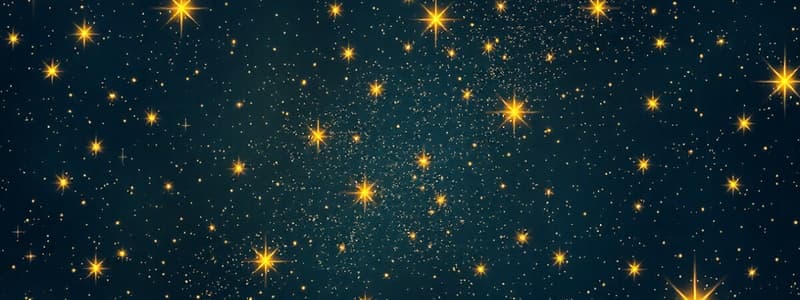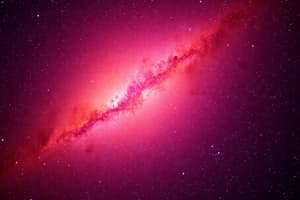Podcast
Questions and Answers
A binary star system exhibits an orbital period that is incongruously short, accompanied by significant X-ray emissions. Spectroscopic analysis reveals one component to be a rapidly rotating, late-stage main sequence star and the other a compact object exceeding the Chandrasekhar limit, yet displaying no observable event horizon. Which of the following exotic stellar configurations most plausibly explains these combined observations?
A binary star system exhibits an orbital period that is incongruously short, accompanied by significant X-ray emissions. Spectroscopic analysis reveals one component to be a rapidly rotating, late-stage main sequence star and the other a compact object exceeding the Chandrasekhar limit, yet displaying no observable event horizon. Which of the following exotic stellar configurations most plausibly explains these combined observations?
- A quark star exhibiting a crystalline color-flavor-locked (CFL) phase in its core, surrounded by a thin crust of conventional nuclear matter, accreting from its Roche-lobe filling companion. (correct)
- A rapidly accreting neutron star exhibiting quasi-periodic oscillations (QPOs) coupled with a low-mass main sequence companion undergoing tidal disruption.
- An electrovac black hole mimicker (EBHM) supported by quantum vacuum polarization effects evading the formation of an event horizon, interacting with a synchronized main-sequence star.
- A Thorne–Żytkow object formed from the merger of a red giant and a neutron star, producing atypical nucleosynthesis products in its extended atmosphere.
Consider a population of stars within a globular cluster exhibiting a bimodal horizontal branch morphology. A subset of these stars demonstrates anomalously high atmospheric fluorine abundances coupled with suppressed lithium lines. Which of the following stellar evolution mechanisms most accurately accounts for these observations?
Consider a population of stars within a globular cluster exhibiting a bimodal horizontal branch morphology. A subset of these stars demonstrates anomalously high atmospheric fluorine abundances coupled with suppressed lithium lines. Which of the following stellar evolution mechanisms most accurately accounts for these observations?
- Thermally pulsing AGB stars experiencing third dredge-up episodes followed by cool bottom processing, resulting in the synthesis and transport of fluorine to the stellar surface.
- Deep mixing processes induced by rotationally-driven shear instabilities in low-mass asymptotic giant branch (AGB) stars subsequent to the third dredge-up event. (correct)
- Hot bottom burning occurring in intermediate-mass AGB stars, leading to the activation of the Ne-Na and Mg-Al chains, facilitating fluorine production and lithium depletion.
- Ingestion of close-orbiting substellar companions by red giant branch (RGB) stars, triggering non-standard mixing and surface abundance anomalies.
A star exhibits an anomalously high luminosity for its surface temperature when plotted on the Hertzsprung-Russell diagram, and its spectra reveals strong absorption lines of technetium (Tc). Concurrent observations indicate irregular pulsations and significant mass loss. Which evolutionary stage is this star most likely experiencing?
A star exhibits an anomalously high luminosity for its surface temperature when plotted on the Hertzsprung-Russell diagram, and its spectra reveals strong absorption lines of technetium (Tc). Concurrent observations indicate irregular pulsations and significant mass loss. Which evolutionary stage is this star most likely experiencing?
- Pre-main sequence phase characterized by episodic accretion bursts and deuterium burning.
- Asymptotic Giant Branch (AGB) phase undergoing third dredge-up events and thermal pulses. (correct)
- Wolf-Rayet star experiencing strong stellar winds and heavy mass loss due to radiation pressure.
- Luminous Blue Variable (LBV) undergoing S Doradus-type eruptions and shell ejections.
A newly discovered star cluster exhibits a main-sequence turnoff point in the blue straggler region, an overabundance of rapidly rotating Be stars, and an age derived from isochrone fitting that significantly exceeds the dynamical relaxation timescale of the cluster core. Which of the following scenarios best explains these seemingly contradictory observations?
A newly discovered star cluster exhibits a main-sequence turnoff point in the blue straggler region, an overabundance of rapidly rotating Be stars, and an age derived from isochrone fitting that significantly exceeds the dynamical relaxation timescale of the cluster core. Which of the following scenarios best explains these seemingly contradictory observations?
In the context of stellar classification, consider two stars with identical effective temperatures. Star A exhibits significantly broader and shallower spectral lines compared to Star B. Assuming both stars are main sequence stars, which of the following physical properties most likely accounts for the observed difference in spectral line characteristics?
In the context of stellar classification, consider two stars with identical effective temperatures. Star A exhibits significantly broader and shallower spectral lines compared to Star B. Assuming both stars are main sequence stars, which of the following physical properties most likely accounts for the observed difference in spectral line characteristics?
Flashcards
What are stars?
What are stars?
Massive, glowing spheres of hot gas (mostly hydrogen and helium) that generate light and energy through nuclear fusion.
Apparent Magnitude
Apparent Magnitude
Brightness as seen from Earth.
Absolute Magnitude
Absolute Magnitude
Actual brightness of a star at a standard distance (32.6 light-years).
Star Color
Star Color
Signup and view all the flashcards
Star Color Sequence (Hottest to Coolest)
Star Color Sequence (Hottest to Coolest)
Signup and view all the flashcards
Study Notes
- Stars are massive, glowing spheres of hot gas, mainly hydrogen and helium.
- Stars produce light and energy through nuclear fusion.
Brightness
- The brightness indicates a star's size, with larger stars having more luminosity.
- Apparent magnitude is how bright a star appears from Earth.
- Absolute magnitude is the actual brightness of a star at a standard distance of 32.6 light-years.
Color
- The color indicates its surface temperature; hotter stars are bluer, while cooler stars are redder.
- Blue stars have a temperature of over 25,000°C (e.g., Rigel).
- White stars have a temperature of around 10,000°C (e.g., Sirius).
- Yellow stars have a temperature of around 5,500°C (e.g., the Sun).
- Orange stars have a temperature of around 4000°C (e.g., Aldebaran).
- Red stars have the coolest temperatures.
Studying That Suits You
Use AI to generate personalized quizzes and flashcards to suit your learning preferences.




